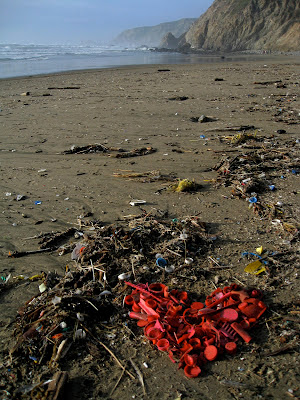We met in the fall of 1999 at Electric Works, Richard's gallery and printing business. Judith had come seeking advice about a book she wanted to publish. Photos of Kehoe Beach strewn on a conference table from a previous meeting prompted the question, “You've never been there?” “I'll show you,” Richard says, and we made a date. At the beach, we both begin picking up plastic bits in the wrack-line. “You gonna keep that?” we ask each other almost simultaneously. It’s a funny business, serendipity, but both of us had been gleaning plastic and making artwork out of it since 1996.
What are the chances that we each could find a kindred soul who had for years been doing this obsessive picking up? Both of us artists, with a lot of painting, drawing, and a similar preclusion for re-contexting found objects, who knew the importance of letting the materials speak.
You say "collaboration" and know it's a joint effort. Two players in a game. Our sixty years of collective art making put a lot of good things on the table, a lot of experience and a well developed stance; methodologies honed into habit, we knew what we were about in our respective studios. Now we were working together.
Right in the beginning contentions rose up but we developed a workable routine:
From door to shore Kehoe Beach is about 35 minutes from where we live. Usually in an hour or maybe two we can fill our collecting bags with as much as we can carry back, about 50 pounds.
At home the plastic is washed and dried—then the real fun begins— we sort the plastic by size, by color, by kind.
We then use this material to shape arrangements that are transported to Richard’s business Electric Works in San Francisco where the work is photographed and printed. Like the plastic that washes onto shore the plastic we have used in our arrangements goes back into our “inventory” to be used in future configurations. The photographs then go out into the world for exhibition in galleries, museums and art spaces to entice and educate the public about the perils of plastic pollution. Since we are concerned about the carbon footprint of crating and shipping heavy works of art, when possible our high resolution files are sent to venues where the images can be printed on site.
Even though the impulse often rears up, we try not to make “something” like a fish or a bird or a portrait or a landscape. We return to our earliest art training in the abstract notions generated by the famous Bauhaus school in Germany. Ideas of rhythm and line, shape and color come into the work—musical composition is the most relevant metaphor.
As dedicated artists with years of studio experience we want to talk to a broad audience curious about what artists do and why. We have been following a path of discovery and we feel this path opens possibilities to the creative life for everyone.






































